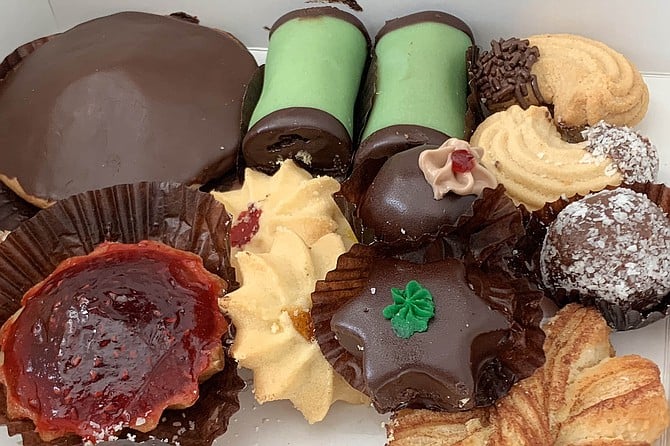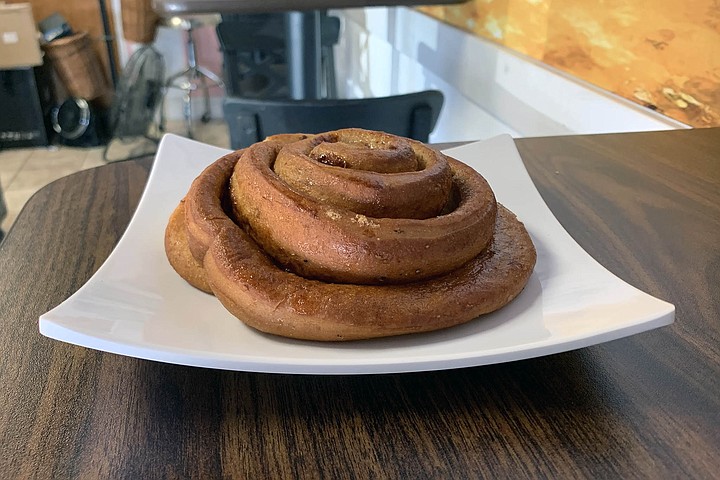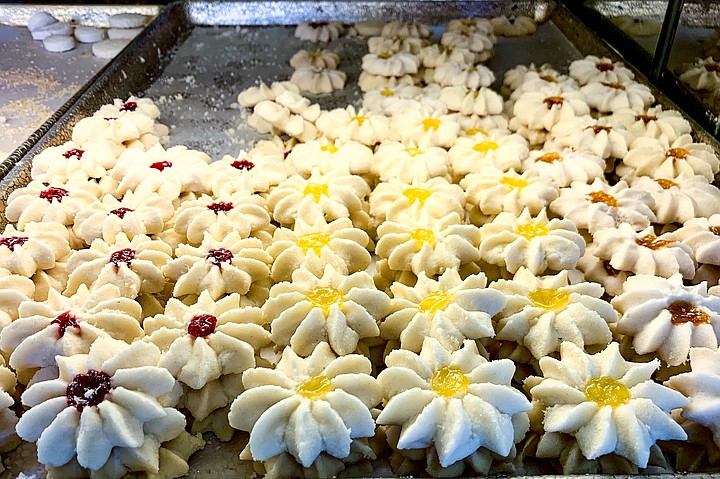 Facebook
Facebook
 X
X
 Instagram
Instagram
 TikTok
TikTok
 Youtube
Youtube

A lot of new information has come to light since I learned there is a Swedish bakery in Poway. For example, did you know there’s a distinctly Swedish baking tradition?
Somehow, in my case, this got lost in an adult lifetime focused on French, Mexican, Jewish, and even Filipino baked goods. But it appears to be part and parcel of the tradition known as fika. Conceptually, the Swedish fika sits somewhere between the American coffee break and English afternoon tea: it’s a daily ritual that involves taking time to sit with friends to enjoy coffee and pastries. And the latter includes a unique assortment of pastries I found in plentitude at Poway’s Swedish Royal Bakery.

Turns out, option number one is my all time favorite pastry: the humble cinnamon roll ($2.25). It was news to me that the Swedish invented cinnamon rolls, a.k.a. kanelbulle (which means cinnamon bun, though I’m partial to the more descriptive Danish term, kanelsnegl, or cinnamon snail). Swedish baking is said to favor simplicity, so it’s no surprise that, compared to the gooey examples established within the food courts American shopping malls, this bakery’s cinnamon rolls come out relatively flat, without a thick coat of sugary glaze. I can’t pretend my ‘Merican tastebuds didn’t miss the glaze, but this roll did benefit from a hint of what I first took to be star anise, but is more likely a dash of cardamom to complement the cinnamon.

The most immediate standout within the glass case of Swedish Royal Bakery, and the clearest sign you’re in a Swedish bakery (if its name didn’t convince you), are the so called green rolls, which turn out to be an example of punchrulle, or punsch rolls ($3.25). Green marzipan exteriors gives them color, while the ends of each roll have been dipped in chocolate. Inside is an almost truffle-like chocolate cake flavored with a dose of punsch, a Swedish liqueur flavored with tea and spice. It’s more rich than I thought Swedish food capable.
Almond seems to make a frequent appearance in fika pastries. It’s part of the cookie mixture going into my raspberry mazarin ($2.25), which here looks like a tiny pie filled with raspberry jam. Similar, but much more decadent, was my favorite pastry made by Swedish Royal Bakery: biskivi, specifically a chokladbiskvi, or chocolate biscuit. This one takes its sort of almond cookie pie crust and fills it with chocolate mousse, then dips it in chocolate to form a hard top crust.

Rounding out my order (and belly) were coconut encrusted chocolate rumballs (chokladboll, $1.25), truffle-like cream buns (gräddbulle, $1.25), Bavarian cream filled vanilla hearts (vaniljhjärta, $2.25), and assorted cookies sweetened by cinnamon, sugar, and/or fruit jellies (50 cents to $1.50 apiece). I don’t know how many in Poway observe fika coffee breaks, but the option is certainly there, and it’s super sweet.


A lot of new information has come to light since I learned there is a Swedish bakery in Poway. For example, did you know there’s a distinctly Swedish baking tradition?
Somehow, in my case, this got lost in an adult lifetime focused on French, Mexican, Jewish, and even Filipino baked goods. But it appears to be part and parcel of the tradition known as fika. Conceptually, the Swedish fika sits somewhere between the American coffee break and English afternoon tea: it’s a daily ritual that involves taking time to sit with friends to enjoy coffee and pastries. And the latter includes a unique assortment of pastries I found in plentitude at Poway’s Swedish Royal Bakery.

Turns out, option number one is my all time favorite pastry: the humble cinnamon roll ($2.25). It was news to me that the Swedish invented cinnamon rolls, a.k.a. kanelbulle (which means cinnamon bun, though I’m partial to the more descriptive Danish term, kanelsnegl, or cinnamon snail). Swedish baking is said to favor simplicity, so it’s no surprise that, compared to the gooey examples established within the food courts American shopping malls, this bakery’s cinnamon rolls come out relatively flat, without a thick coat of sugary glaze. I can’t pretend my ‘Merican tastebuds didn’t miss the glaze, but this roll did benefit from a hint of what I first took to be star anise, but is more likely a dash of cardamom to complement the cinnamon.

The most immediate standout within the glass case of Swedish Royal Bakery, and the clearest sign you’re in a Swedish bakery (if its name didn’t convince you), are the so called green rolls, which turn out to be an example of punchrulle, or punsch rolls ($3.25). Green marzipan exteriors gives them color, while the ends of each roll have been dipped in chocolate. Inside is an almost truffle-like chocolate cake flavored with a dose of punsch, a Swedish liqueur flavored with tea and spice. It’s more rich than I thought Swedish food capable.
Almond seems to make a frequent appearance in fika pastries. It’s part of the cookie mixture going into my raspberry mazarin ($2.25), which here looks like a tiny pie filled with raspberry jam. Similar, but much more decadent, was my favorite pastry made by Swedish Royal Bakery: biskivi, specifically a chokladbiskvi, or chocolate biscuit. This one takes its sort of almond cookie pie crust and fills it with chocolate mousse, then dips it in chocolate to form a hard top crust.

Rounding out my order (and belly) were coconut encrusted chocolate rumballs (chokladboll, $1.25), truffle-like cream buns (gräddbulle, $1.25), Bavarian cream filled vanilla hearts (vaniljhjärta, $2.25), and assorted cookies sweetened by cinnamon, sugar, and/or fruit jellies (50 cents to $1.50 apiece). I don’t know how many in Poway observe fika coffee breaks, but the option is certainly there, and it’s super sweet.
Comments